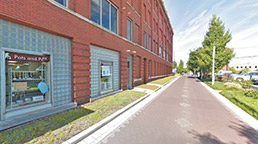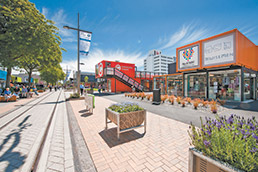Subscriber Benefit
As a subscriber you can listen to articles at work, in the car, or while you work out. Subscribe Now Applause to the Phoenix Theatre, which broke ground on its new home May 2. I have long admired the organization’s attitude and approach, even while not experiencing nearly enough of its performances. The theater’s new location speaks to something that seems to be embedded in the values of the Phoenix: the desire to be meaningful to the community beyond the stage. Clearly, moving its productions to the northeast corner of Illinois and Walnut streets will put this to the test.
Applause to the Phoenix Theatre, which broke ground on its new home May 2. I have long admired the organization’s attitude and approach, even while not experiencing nearly enough of its performances. The theater’s new location speaks to something that seems to be embedded in the values of the Phoenix: the desire to be meaningful to the community beyond the stage. Clearly, moving its productions to the northeast corner of Illinois and Walnut streets will put this to the test.
There is no affectionate name for the collection of blocks surrounding the soon-to-be-reborn Phoenix—an area from North Street to 11th Street bounded on the east and west by the Illinois Street and Senate Avenue corridors.
It is hard to imagine that, for three-quarters of its nearly 200-year history, the area looked similar to revered downtown neighborhoods like St. Joseph, Chatham Arch and Lockerbie Square. Even in its more industrial era—which was at its peak with the addition of the Stutz Motor Co.—houses, factories and storefronts co-existed, just like Real Silk and the Lockerbie Glove Co. did in their downtown neighborhoods.
But vacancy and decline crept in during the Great Depression and World War II. The three successive automobile-dominated decades that began with the 1950s brought one-way streets, surface parking and highway access. They transformed the area from a neighborhood into a collection of service and support uses. In the area today, there are fewer sites with buildings on them than without. And it feels maddeningly stranded—just out of reach of the urban regeneration happening along the Central Canal, in the Meridian Street corridor, and throughout the Mile Square.
 This is not to suggest the area has been forgotten. One of the most significant legs of the Cultural Trail—the Glick Peace Walk—passes through as it connects the American Legion Mall to the canal. The area will have rapid transit in its core with the Red Line traversing the Capitol Avenue corridor. But the area’s greatest assets are, perhaps, the businesses and property owners who recognize its potential and have dedicated themselves to its long-term rejuvenation despite the glacial pace.
This is not to suggest the area has been forgotten. One of the most significant legs of the Cultural Trail—the Glick Peace Walk—passes through as it connects the American Legion Mall to the canal. The area will have rapid transit in its core with the Red Line traversing the Capitol Avenue corridor. But the area’s greatest assets are, perhaps, the businesses and property owners who recognize its potential and have dedicated themselves to its long-term rejuvenation despite the glacial pace.
 Turning Illinois Street and Senate and Capitol avenues into a downtown neighborhood again will require two-way streets and activating the section of the Indianapolis Cultural Trail that spans the district (top). Christchurch, New Zealand, successfully revived a neighborhood with a similar strategy. (Photos courtesy of Ratio and Re:Start)
Turning Illinois Street and Senate and Capitol avenues into a downtown neighborhood again will require two-way streets and activating the section of the Indianapolis Cultural Trail that spans the district (top). Christchurch, New Zealand, successfully revived a neighborhood with a similar strategy. (Photos courtesy of Ratio and Re:Start)Taking a cue from the Phoenix, here are a few ideas for the area that could challenge and inspire:
• Thoughtfully restore the area’s streets to two-way traffic and take advantage of the intact secondary street/alley network. Of the many structural challenges that exist in the area, one of the most detrimental to its identity is the configuration of its streets. The dominant one-way network reinforces the pass-through nature of the area and has essentially turned Illinois Street and Senate Avenue into giant back alleys for buildings on Meridian and the Canal. In the end, access to the area is important, but street “walkability” is even more essential to creating lively, fine-grained places that are synonymous with urban living.
• Double down on the arts. The Stutz has been a beachhead for artists and creatives for over a decade. Last year, IN Light IN electrified the area with dynamic and interactive light and media installations. Perhaps institutions like the Kurt Vonnegut Memorial Library and iMOCA, both looking for new homes, could join the Phoenix in the endeavor to create a district. Synergies between cultural and artistic venues, in addition to strengthening the individual organizations, could provide more regular day and night activity and, if we are lucky, more events like IN Light IN.
• Create a “pop-up” village square. Clearly, hospitality and retail opportunities are limited in the area. Even more concerning is that the area lacks a definable center or a place where spontaneous interaction and collaboration can happen. With its existing pioneering spirit and the addition of more artistic energy, the area is ripe for exploration and experimentation. Places like re:Start in Christchurch, New Zealand, one of the best shipping-container villages I have ever come across, are helping to establish authentic community and provide opportunity where it was lost or never existed. Best of all, most are doing it at the scale of individual makers and small business.
The Phoenix has set the signal fire. Who’s in?•
__________
Gallagher is an urban designer with Ratio.
Please enable JavaScript to view this content.
